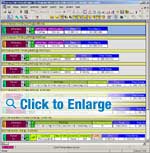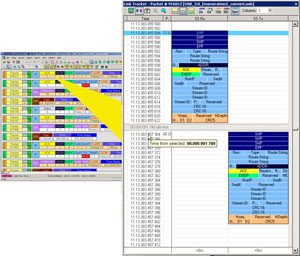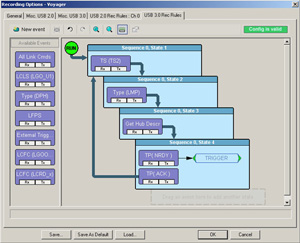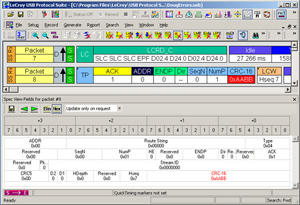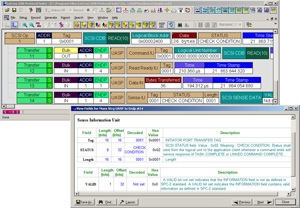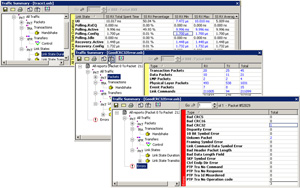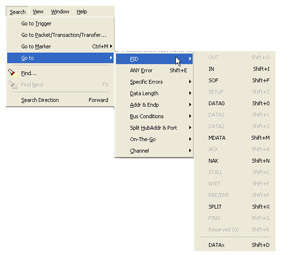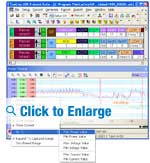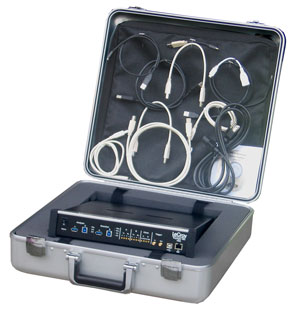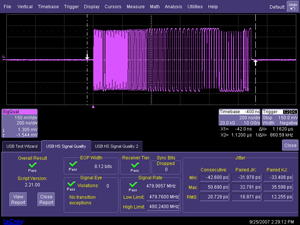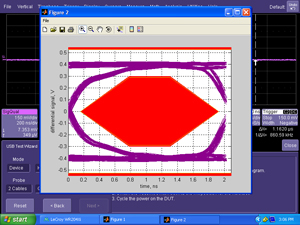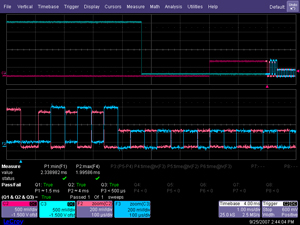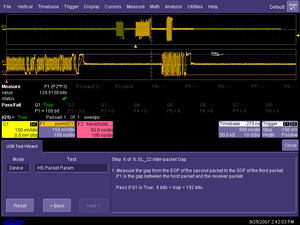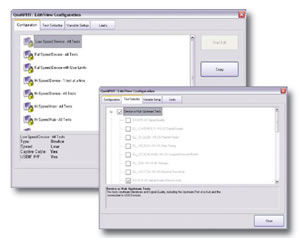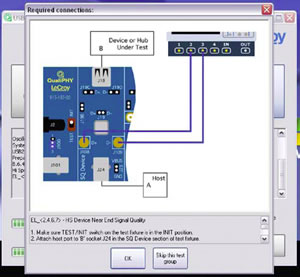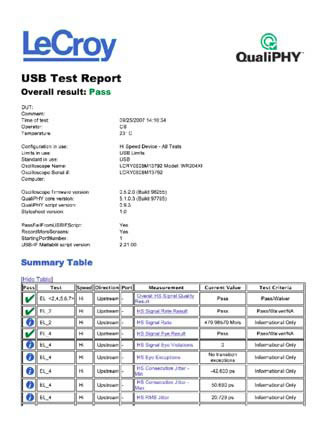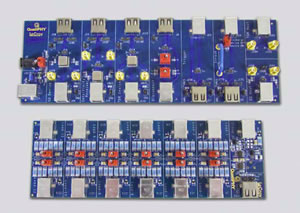Conquest
The LeCroy Conquest™ USB Protocol Analyzer System provides comprehensive USB analysis features at an extraordinary price point. Comprehensive USB device level decoding makes it easy to understand and debug transactions occurring at the system level. Designed for easy setup with time saving features like predefined trigger settings, the Conquest is equally suited for both first-time and advanced users.
LeCroy has developed six generations of its industry leading USB protocol verification system since the introduction of USB in 1995. Each successive generation of the LeCroy USB analyzer family has built upon the previous knowledge and expertise. Today, LeCroy offers a broad range of USB test systems with unprecedented functionality, accuracy and user friendliness. The enormous cost of discovering problems after a product is released far outweighs the investment in LeCroy's de-facto standard USB analysis tools. Their use improves the speed and efficiency of the debug, test and verification for USB semiconductor, device, and software vendors. Analyzers or bus "sniffers" also play an essential role in avoiding costly interoperability problems by allowing developers to verify compliance with the USB specification.
Consistent with the growing popularity of digital media, the USB-IF announced USB 3.0 in late 2007 targeting 10X the current USB bandwidth by utilizing two additional high-speed differential pairs for "SuperSpeed" transfer mode. The USB 3.0 specification was released in late 2008 and commercial products began shipping in late 2009. LeCroy has pioneered the development of verifications systems for this new technology. The only company that offers a complete line of USB 3.0 test solutions covering transmitter test to protocol test, and every step in between, LeCroy helps developers achieve their goals of performance, quality, reliability and time-to-market for SuperSpeed technology.
USB Technology Overview:USB, or Universal Serial Bus, is a connectivity standard that enables computer peripherals and consumer electronics to be connected to a computer without reconfiguring the system or opening the computer box to install interface cards. The USB 1.0 specification was introduced in January 1996. The original USB 1.0 specification had a data transfer rate of 12 Mbit/s The first widely used version of USB was 1.1, which was released in September 1998. It provided 12 Mbps data rate for higher-speed devices such as disk drives, and a lower 1.5 Mbps rate for low bandwidth devices such as joysticks. USB 2.0 specification was released in April 2000 and was ratified by the USB-IF at the end of 2001 to develop a higher data transfer rate, with the resulting specification achieving 480 Mbit/s
USB today provides a fast, bi-directional, low-cost, serial interface that offers easy connectivity to PCs. A hallmark for USB operation has been the ability for the host to automatically recognize devices as they are attached and install the appropriate drivers. With features such as backward compatibility with previous devices and hot "plug-ability", USB has become the de-facto standard interface for various consumer and PC peripheral devices. The USB standard allows up to 127 devices connected to a Host System. USB designates low, full, high-speed connectivity between devices compatible with the 2.0 specification. Most full speed devices include lower bandwidth mice, keyboards, printers, and joysticks. The use of high speed USB has exploded with the rapid growth in digital media in the consumer electronics market including media players, digital cameras, external storage and smart phones.
SuperSpeed USB is designator for links operating at the 5 GHz frequency and compatible with the USB 3.0 specification. SuperSpeed USB provides a high performance connection topology for applications that utilize larger files or require higher bandwidth. SuperSpeed USB is backward compatible with USB 2.0, resulting in a seamless transition process for the end user. SuperSpeed USB offers a compelling opportunity for digital imaging and media device vendors to migrate their designs to higher performance USB 3.0 capable interface.
NEC/Renesas was the first chip vendor to introduce host controllers for USB 3.0 (5/18/2009). The first motherboards featuring USB 3.0 ports from Asus and Gigabyte followed in late 2009. In the first half of 2010, dozens of SuperSpeed devices began shipping as vendors rushed to deliver solutions using the 5Gbps signaling speed of USB 3.0. Expect mass adoption into high-bandwidth applications in late 2010.
Why USB?From its emergence in 1995 as a low-cost connection interface for keyboards and mice, USB has steadily expanded its presence in computing and consumer electronics to become the most popular peripheral interconnect in history. USB continues to be dominant for the following reasons:
- Mature, proven technology
- Backward-compatible and low cost
- Easy plug and play operation
- Data transfer speeds suitable for a variety of applications
As evidenced by USB popularity, several extensions of the technology have been introduced to try and capitalize on its installed base/ popularity. An example of this extension, which is supported and approved by the USB Implementers Forum (USB-IF), is USB On-The-Go (OTG). Designed to allow portable computing devices, such as cell phones and digital cameras, the ability to connect to other USB devices as either a host or peripheral, OTG promises improved interoperability for an enormous number of USB enabled devices.
In addition, there are now dozens of USB device classes addressing everything from health care systems to isochronous video applications. Mass storage remains one of the most popular USB applications as consumers have embraced all types of digital media. The T10 committee has now finalized USB Attached SCSI (UAS) protocol which enables several significant improvements over legacy mass storage protocols including command queuing and streamed IO. Of particular interest is the new battery charging specification which provides a standard mechanism allowing devices to draw current in excess of the USB specification when connected to wall chargers or fast charging host controllers. In addition to the traditional data interchange application, the battery charging specification has solidified USB's dominant role as the interface of choice in the portable electronics market.
USB ArchitectureUSB was initially introduced as a host to peripheral interconnect with the goal of putting most of the intelligence on the host-side. The OTG specification added an optional peer-to-peer capability to devices but had limited adoption to date. So the vast majority of USB devices typically fall into 2 categories:
- Hosts
- PCs, Macs and laptops
- Peripherals
- All devices designed to attach to a host (examples)
The role of the host controller (plus software) is to provide a uniform view of IO systems for all applications software. For the USB IO subsystem in particular, the host manages the dynamic attach and detach of peripherals. It automatically performs the enumeration stage of device initialization which involves communicating with the peripheral to discover the identity of a device driver that it should load, if not already loaded. It also provides device descriptor information that drivers can use enable specific features on the device. Peripherals add functionality to the host system or may be standalone embedded operation. When operating as a USB device, peripherals act are slaves that obey a defined protocol. They must react to requests sent from the host. It's largely the role of PC software to manage device power without user interaction to minimize overall power consumption. The USB 3.0 specification redefines power management to occur at the hardware level with multiple power states designed to reduce power usage across the IO system.
LinksConquest Pro Protocol Analyzer / Exerciser System
The Conquest Pro provides an all-in-one protocol analysis and exerciser system for a range of USB development applications. In addition to supporting all USB 2.0 bus speeds, this comprehensive test solution includes the easy-to-understand Conquest display of bus traffic, protocol error detection, advanced triggering, traffic generation, plus special timing and DC Compliance measurements. This powerful tool, with an unprecedented array of deep features, is well suited for use by firmware, device, and system engineers in all phases of product development.
System OverviewThe Conquest Pro is a multi-function USB 2.0 serial bus analyzer capable of analyzing data transfers of up to 480Mb/s. The Conquest Pro is available with protocol analysis capability only, or it may be configured to capture and analyze data while the exerciser generates traffic on the bus.
In the analyzer mode, the Pro provides one fully non-intrusive recording channel for capture of USB 2.0 traffic, including slower than standard signaling frequencies. OTG traffic capture is fully supported as well. The user is provided with the option to view captured traffic in a Catalyst Trace view, timing view, or both views.
Two modes are provided for operating the analyzer; easy mode and advanced mode. In the easy mode, an extensive list of predefined trigger points are provided, and several convenient filters are available to exclude redundant USB traffic and events. The advanced mode provides a 32-level state sequencer, which allows sophisticated control of the capture and trigger sequence.
Captured USB traffic is displayed in an easy-to-understand Graphical Trace view with collapsible transfer/transaction display to quickly zero in on specific location of the bus traffic. Captured traffic can be saved to various formats, such as binary, text, and NRZI, as well as in Trace view format. An extensive array of USB class decodes is provided for detailed decoding of class-specific transfers. These decodes can be user-edited with Catalyst’s Advanced Script Language (ASL) editor. The ASL editor can also be used to create custom, proprietary decodes.
A detailed statistical report provides instant qualitative and quantitative information on the captured bus traffic, including a fast-search feature whereby the capture instantly jumps to the selected packet or event highlighted in the statistics report.
A data payload report breaks down captured payloads and provides its own statistical summary on this information, including a byte value distribution graph as well as additional quick-search features. Additional features include save-as-text, copy options, quick filters, and various display control and formatting options.
The analyzer can detect and trigger on several different USB protocol errors in real time, along with detection of numerous post-capture protocol errors.
Analyzer Features- Protocol error detection
- Multi-state event triggering
- Non-standard speed support
- Time and event counters
- Transaction/packet/event search and filter functions
- Payload data report with associated data distribution chart
- Statistics on packets, events, transactions, transfers, errors, and performance
- Quick data search
- Save as text, NRZI, or standard format
- Export payload or packets/events captured for use by exerciser
- Upper-level protocol decodes and custom protocol editor interface
- Over-sampling timing mode
- 384MB of capture memory
- In normal recording mode it displays real time performance analysis metrics to help isolate protocol layer problems
- In performance analyzer mode, throughput, bus utilization and efficiency are monitored in real time
- Offers special ports for PHY electrical testing including Vbus, Vdroop, inrush, suspend/resume and current measurements (in operating and unconfigured modes)
- Supports OTG both in protocol capture and device emulation modes
| Feature | Conquest Standard | Conquest Advanced | Conquest Pro | Conquest Pro Exerciser |
| Low Speed (1.5 Mb/s) and Full Speed (12 Mb/s) | ? | ? | ? | ? |
| High Speed (480 Mb/s) | ? | ? | ? | ? |
| Trace Memory Size | 128 MB | 128 MB | 394 MB | 394 MB |
| Upload to Host via USB 2.0 or LAN | ? | ? | ? | ? |
| Global & Raw Bit View | ? | ? | ? | ? |
| View Hex, Decimal or Binary | ? | ? | ? | ? |
| Search on Errors | ? | ? | ? | ? |
| Search within Data Payload | ? | ? | ? | ? |
| Export Text / ASCII / Binary | ? | ? | ? | ? |
| Snapshot Capture | ? | ? | ? | ? |
| Upper-level USB Class Decodes | ? | ? | ? | ? |
| User-defined Decodes | ? | ? | ? | ? |
| Single-level Event Triggering (Easy mode) | ? | ? | ? | ? |
| Trigger on Protocol Errors | ? | ? | ? | ? |
| Trigger on Setup / In / Out / Data / Ping | ? | ? | ? | ? |
| Statistical Reports | ? | ? | ? | |
| Multi-level Event Triggering (Advanced mode) | ? | ? | ? | |
| Trigger on Split Setup Transaction | ? | ? | ? | |
| Trigger on Split Bulk In/Out Transaction | ? | ? | ? | |
| Trigger on Split Interrupt In/Out Transaction | ? | ? | ? | |
| Trigger on Split Isoch In/Out Transaction | ? | ? | ? | |
| Filter In / Out specific Address / Endpoints | ? | ? | ? | |
| Trigger on Data Pattern and Length | ? | ? | ||
| Trigger on Vbus & Operating Current | ? | ? | ||
| Event Counters | ? | ? | ||
| Event Timers | ? | ? | ||
| Slow-clock Capability | ? | ? | ||
| Auto Run (multiple trace capture) | ? | ? | ||
| Auto detect Speed | ? | ? | ||
| Performance Analyzer (Easy \ Adv. Option) | ? | ? | ||
| OTG Analysis | ? | ? | ||
| Timing Analysis Display | ? | ? | ||
| Real Time statistics & throughput | ? | ? | ||
| DC Compliance measurement | ? | ? | ||
| Exerciser Graphical User Interface (GUI) | ? | |||
| Traffic Generation / Host emulation | ? | |||
| Simultaneous Transmit and Record | ? | |||
| Find Device VID / PID | ? | |||
| Device emulation | ? | |||
| OTG Device Emulation | ? |
The host exerciser enables the user to emulate a USB host for purposes of testing a USB device. Traffic generated by the exerciser is captured and displayed by the analyzer, providing a fully self contained test environment. Custom USB transfers and packets can be constructed with an easy-to-use graphical interface. The user can modify packet fields, loop or iterate specified sequences, and control NAK and error retry characteristics. The exerciser is capable of transmitting large data payloads, automatically breaking them into several transactions to generate a single transfer. An array of error generation features is available to test device reaction to illegal and malformed packets, events, or transfers.
Exerciser Features- Automatically spreads large payloads over multiple transactions
- Record and playback of captured packets and bus events
- Adjustable bit width of packet fields and other error injection features
- Automatic retry of failed transactions (fully controllable)
- Loop selected exerciser sequences or entire sequence
- Control of host handshakes
- Replay captured payload data or call pre-defined data blocks
- One-click auto-build for insertion of complex control transfers
The device emulation feature simulates standard or non-standard device behavior, which is crucial for testing USB host controllers. An easy-to-use GUI displays device hierarchy for quick configuration or descriptors and other configuration characteristics. Device handshakes are fully controlled, as are all device responses to the host, including pre-programmed errors, payload data, and configuration data.
OTG ExerciserThe Conquest Pro provides complete analysis and exerciser capabilities for OTG. All Details of OTG Sessions are captured and displayed, including HNP and SRP events. The OTG exerciser emulates either the A or B device, including a user-defined traffic sequences, response settings for data line/VBus pulsing, and full suite of error injection functions. Once defined and activated, the device emulator runs independent of other analyzer functions.
Timing AnalyzerThe timing analyzer over-samples USB traffic at rates to 1.44GHz and produces a waveform view of the D+ and D- lines to discover various electrically-oriented issues on the bus. Skew, jitter, EOP errors and several other anomalies are quickly identifiable in this mode. Timing captures can optionally be correlated with the protocol view. Triggering the timing analyzer can be done either through the standard analyzer triggers or by direct definition of the states of the D+ and D- lines.
DC Compliance Test SuiteA suite of Automated DC Compliance Tests is provided in both qualitative/quantitative and pass/fail formats, based on up-to-date compliance specifications. For DC current measurements, live values, averages, and peak measurements are graphically displayed. Inrush and VDroop tests are displayed in graph form, with voltage/current measurements displayed over time, along with quantitative and pass/fail displays. The analyzer also provides triggers for both VBus and operating current threshold values.
The DC Compliance Test Suite includes:- Operating Current
- Suspend Current
- Unconfigured current
- VBus
- VDroop
- Inrush
The Conquest Pro real-time protocol error detection feature allows the user to detect & trigger on pre-defined protocol violations across all layers of the protocol, in real-time. The user simply selects the error, or errors, to be monitored and executes the capture. Errors detected cause the analyzer to trigger and highlight the error(s) inline with the rest of the packets and events. Once the analyzer is armed with trigger on protocol error(s) it will continue to monitor the bus indefinitely until an error is detected or stopped by the user. Additionally, with every capture, the Conquest Pro software automatically detects and flags more than 20 additional protocol errors.
Performance AnalysisThe real-time performance analysis mode provides a graphical "finger-on-the-pulse" indication of bus activity. Metrics include bus utilization, throughput, idle time, average data payload, ACK/NAK ratio and other important characteristics. Custom performance items can be measured by building user-defined performance mathematical expressions
. Performance CharacterizationThe real-time performance analysis feature can also be operated in conjunction with the exerciser, allowing the user to characterize a design under precisely controlled conditions. For example, the exerciser may be used to loop through an exerciser project of read commands, while the performance analysis utility reports on other useful metrics including average data payload or ACK/NAK ratios.








